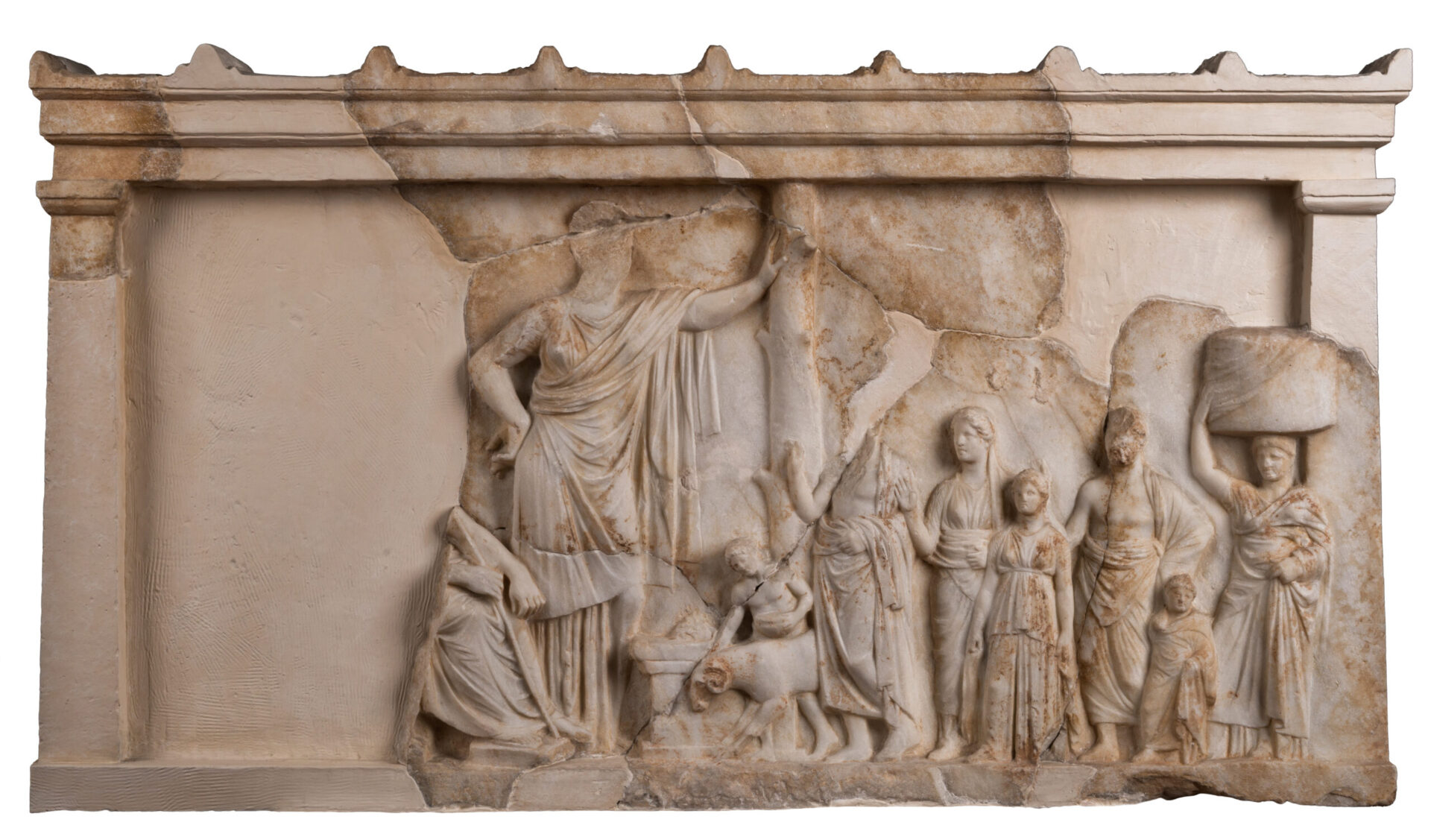Exhibit of the month
“Who cuts down my beautiful trees?”(Callimachus, Hymn to Demeter, 6.41)
An ecological message of a Greek goddess from the 3rd c. B.C.
Votive relief
Hellenic National Archaeological Museum
Sculpture Collection, inv. no. Γ1333
Provenance: Found in 1876 in the Asclepieion of Athens, on the South Slope of the Acropolis
Dimensions: height 0.73 m
Date: 330-320 BC
Display: Hall 25
In some sculptures, as in our relief, there are indications of the natural landscape that surrounded the sanctuaries. In the middle of the representation of the votive relief EAM Γ1333 from the Asclepieion of Athens, a tall tree with cut branches is represented. The goddess Hygeia on the left gently rests her hand on it. Behind her, part of the figure of the seated Asklepius is preserved. The right part of the sculpture is occupied by a large group of worshipers, about to perform a sacrifice. From the right, a handmaiden carries on her head a kiste, a basket of offerings, following the group of men, women and children of the Athenian family. Low in the center of the scene, next to the sacred tree, a small slave holds a canister of offerings in one hand, while with the other hand he leads a ram to the sacrificial altar. Very often sanctuaries of the healing gods were established in idyllic locations outside the city, suitable for the rejuvenation of body and soul.
The trees in the ancient Greek sanctuaries contributed to the creation of a cool environment that offered spiritual contemplation and prayer. In many cases, however, the trees had at the same time, a mythical status. As the poet Callimachus tells us in his Hymn to Demeter, once Erysichthon went to the sacred grove of Demeter and tried to cut down a tall poplar dedicated to the goddess. The goddess heard the tree in pain as Erysichthon cut it down, became terribly angry and disguised as a priestess, she rushed to protect it. Then she assumed her divine form again and punished him with insatiable hunger and disease. Myth as usual crystallizes and exposes a facet of reality. Thus we know that in historical times, special officials of the sanctuaries ensured that the natural environment in them was not destroyed and threatened, while offenders were fined and prosecuted.
In addition to places of worship, ancient Greek sanctuaries were protected ecosystems. Many times a sanctuary was established in a place of natural beauty, which was already considered a holy place, while plantings were made in the sacred groves that were maintained with special care due to their symbolic importance. In the Temple of Hephaestus in Athens, around the perimeter of the temple, pits have been excavated for planting shrubs. Today in those same pits grow pomegranates and myrtles planted after the modern excavations. In Nemea, the sacred cypress trees dedicated to Zeus were planted. But the trees themselves were objects of worship. The trees and springs on the borders of the temple, that is within the precincts of the sanctuaries, were considered property of the gods and sacred laws protected them in their name. Sometimes the gods are depicted near their trees. In Kos it was forbidden to cut down cypress trees from the sanctuaries of Apollo Kyparissios and Asklepius, with a fine of 1000 drachmas for offenders. In Paros, as we are informed from an inscription, the trees were protected from felling, while corresponding epigraphic information is preserved in many ancient Greek sanctuaries. The preservation and beautification of the environment and the management of water were also the concern of the priests, while large areas – as in Delphi – were protected from various uses as sacred lands belonging to some deity. Many sanctuaries maintained gardens of plants and flowers, such as roses, lilies and violets. The beautification and management of nature in the sanctuaries not only symbolically staged the place, but also defined the cultic activity, protecting the natural or artificial landscape. Ecological consciousness is, therefore, an old request and not only a necessity of the modern era.
Dr Ariadni Klonizaki
INDICATIVE BIBLIOGRAPHY
Barnett, R., “Sacred groves: sacrifice and order in the landscapes of Ancient Greece”, Landscape Journal, 26:2, 2007. University of Wisconsin Press, 152-269.
Dignas, B., “A Day in the Life of a Greek sanctuary”, in Ogden, D. (Ed.), A Companion to Greek Religion, 2007, 163-177.
Dillon, M., ‘The Ecology of the Greek Sanctuary’, Zeitschrift für Papyrologie und Epigraphik 118 (1997), 113-127.
Girard, PF., “Ex-voto à Esculape trouvés sur la pente méridionale de l’Acropole (pl. VII, VIII, IX)”, in Bulletin de correspondence hellénique, 2, 1878, PINE.VII, 71-72.
Leventi, I., 2003. Hygieia in Classical Greek Art (translated from the Greek by C. Zerner, W. Phelps & P. Schultz), Supplementary, Archaeognossia, Athens, 181, no. R70, plate 46 with bibliography, 52 note 36, 60 note 133, 125, 153.
Thompson, D., Griswold N., Garden lore of ancient Athens, Princeton, NJ : American School of Classical Studies at Athens, 1963, 10-11.
Kaltsas, N., 2001. National Archaeological Museum. The Sculptures. Catalogue, Athens: Capon Publications, No. 475, 226, with bibliography.


